|
|
|
Sort Order |
|
|
|
Items / Page
|
|
|
|
|
|
|
| Srl | Item |
| 1 |
ID:
138613
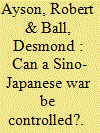

|
|
|
|
|
| Summary/Abstract |
It has been decades since the last war between major powers in Asia, but there is no guarantee that the region will always be able to avoid conflict. The greatest strain on the peace is in North Asia, where there has been rising tension between China and Japan. What begins as a
minor skirmish between China and Japan could conceivably escalate into a more serious conflict that involved the United States and, in the worst case, the use of nuclear weapons by Beijing and Washington. Even a major conventional conflict (between just Japan and China, or
involving all three) could be devastating for North Asia and the wider region, leading to a significant loss of life and widespread political, institutional and economic damage.
|
|
|
|
|
|
|
|
|
|
|
|
|
|
|
|
| 2 |
ID:
138792


|
|
|
|
|
| Summary/Abstract |
When it comes to cyber war, the United States is ambivalent. While persuaded of the utility of offensive cyber operations, it dreads where they might lead. The advantages of cyber war are swamped by the disadvantages if it cannot be kept under control – and there are nagging doubts about whether it can. That computer systems are often interconnected and ultipurpose,
and that there are no sharp ‘firebreaks’ in cyber war, compounds the dangers of escalation to unintended levels and effects, including the disruption of critical civilian services. In a crisis or war, the United States might, despite misgivings, feel compelled to attack computer systems that enable the enemy to strike US forces, only to find itself engaged in cycles of attack and retaliation that produce more pain than gain.
|
|
|
|
|
|
|
|
|
|
|
|
|
|
|
|
| 3 |
ID:
128976
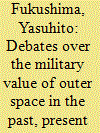

|
|
|
|
|
| Publication |
2013.
|
| Summary/Abstract |
Throughout the Cold War era, U.S. debate over the military value of outer space focused on how space
systems were able to contribute to nuclear deterrence and strategic stability between the U.S. and
Soviet Union. Sanctuary school was the first prevailing view of the debate, and it recognized the value
of outer space in the observation of regions within the boundaries of other sovereign nations. However,
the views of this school were relativized following the inauguration of the Reagan Administration.
As an alternative to the sanctuary school, there was another argument that made headway, which
was that outer space should be positioned as the ultimate high ground and that ballistic missiles
should be intercepted from outer space. Furthermore, following an increase in the military value of
outer space, the idea that space control would become a prerequisite for the utilization of outer space
began to draw interest. In the post-Cold War era, in contrast, the main point of contention has been
about how space systems can contribute to wartime military engagements. The Gulf War saw a rise
in the military value of space systems in terms of C4ISR, and since then the U.S. has maintained its
policy of pursuing the C4ISR value of space systems in military operations. At the same time, as the
perceived value of space systems increased, the view that space control should be established gained
traction. However, when considering the future path of the debate, space control has a number of
issues in terms of feasibility. Additionally, in the long term, the utilization of outer space as the high
ground may become the point of contention. Nonetheless, technical challenges and other issues must
be overcome before space-based BMD systems and other alternatives can be deployed.
|
|
|
|
|
|
|
|
|
|
|
|
|
|
|
|
| 4 |
ID:
119127
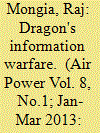

|
|
|
| 5 |
ID:
131221
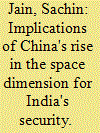

|
|
|
| 6 |
ID:
130152
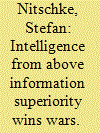

|
|
|
|
|
| Publication |
2013.
|
| Summary/Abstract |
The character of 21st Century warfare is dominated by information warfare and long-range precision
strikes coupled with new forms of C4ISR. This is being achieved by linking intelligence together by a multiplicity of highly advanced sensors carried by high-altitude surveillance platforms, including HALE UAS, purpose-designed AEW&C aircraft, and space-based systems.
|
|
|
|
|
|
|
|
|
|
|
|
|
|
|
|
| 7 |
ID:
130348
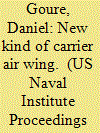

|
|
|
| 8 |
ID:
128686
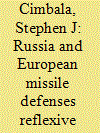

|
|
|
| 9 |
ID:
150963


|
|
|
| 10 |
ID:
149791
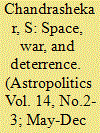

|
|
|
|
|
| Summary/Abstract |
India must accept and deal with the reality that conflicts and wars in today’s world will be driven by the increasing interdependence between conventional, nuclear, and space war. The role of space-based command, control, communications, computers, intelligence, surveillance, and reconnaissance (C4ISR) assets, complemented by other ground- and space-based space situational awareness (SSA) components, is critical for deciding on the new national strategy for waging war and for the deterrence of war. Increasingly, the U.S.-China space dynamic determines the evolution of the global space order. To translate these challenges into an operational capability, India requires, at a minimum, a four-fold increase in capability to launch satellites into various orbits every year. The integration of C4ISR and SSA capabilities into a seamless network that facilitates real-time action is the key organizational and institutional component of the new strategy. More than the technology initiatives, the implementation of this strategy necessitates a clear aspiration on the part of India that it does have an important role to play on the global stage, and that it will carry out the organizational and institutional reforms for defending its national interests and national security.
|
|
|
|
|
|
|
|
|
|
|
|
|
|
|
|
| 11 |
ID:
130811
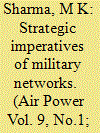

|
|
|
|
|
|
|
|